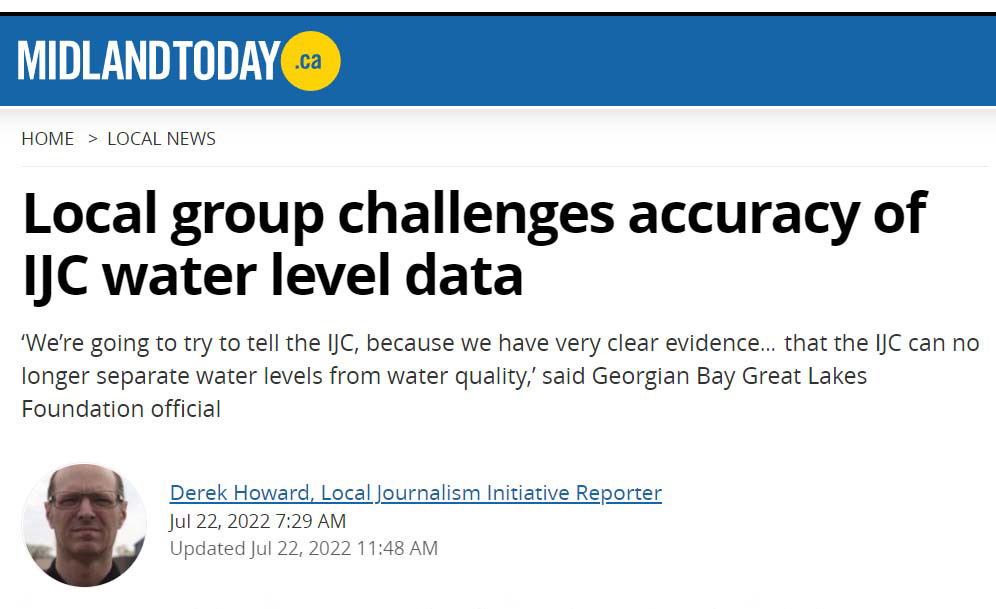The need for water quality along Georgian Bay is no mere drop in the bucket.
Members of the Georgian Bay Great Lakes Foundation (GBGLF) addressed Tiny council at the recent committee of the whole meeting, presenting an update on Georgian Bay water levels and water quality, and asking the township for a letter of support for funding from the federal government.
Mary Muter, chair of the GBGLF, spoke to the extreme high and low water levels recorded over the past two decades.
It was a topic that was spoken about thoroughly in a presentation last year by the International Joint Commission (IJC) to Tiny council, which included a section that showed recorded monthly mean water levels for all five of the Great Lakes, including Lake Superior and Lakes Michigan-Huron in which Georgian Bay is connected.
The GBGLF had issues with the data provided by Environment Canada and Climate Change, stating that the scales had been altered visually and didn’t accurately provide the extremities that Lakes Michigan-Huron were experiencing. Collegially affiliated with the U.S. Army Corps. who also requested the properly-sized scales, the GBGLF went further in their exploration of the matter.
"Our hydraulic control engineer (Bill Bialkowski) got the formula for (IJC “Lake Superior Regulation Plan 2012”) and ran it through the recent two decades of water level data to find out if, in fact, they (IJC) were balancing water level interests. And he was able to clearly demonstrate that they are not balancing interests," said Muter.
“We are pleased that the U.S. Army Corps asked for his full data and his formula for doing that work, and they spent a couple of weeks with their staff going over Bill’s work, and came back and said Bill is correct.”
In a letter to MidlandToday, chief of public affairs William Dowell from the Detroit District of the U.S. Army Corps of Engineers clarified their position regarding the GBGLF and Muter’s statement.
“USACE officials simply agree Mr. Bialkowski’s model is generally simulating water levels and flows correctly, but do not share his opinion concerning the balancing interests,” wrote Dowell.
Muter also provided data from a GBGLF report by W.F. Baird & Associates Coastal Engineers Ltd. which “used empirical approaches based on historical record” for known climate drivers, stating that it was more accurate than predictions made by Environment and Climate Change Canada; the Baird data matched closely with Bialkowski’s revised formulas.
Those predictions were that by 2030, water levels could reach as low as they were in 2013.
“We are definitely on our way down, once again; it’s this wide swing of levels that does not exist for the other Great Lakes,” said Muter. “In fact, I even wonder if places like Chicago understand what is happening in terms of managing water levels on the Great Lakes.”
Muter informed Tiny council that the GBGLF would be attending the Great Lakes Public Forum 2022 in Niagara Falls this September, a triennial event for Canadian and U.S. governments and citizens to discuss binational priorities on the lakes; the IJC will receive public input at the event.
“Basically, we’re going to try to tell the IJC, because we have very clear evidence, that at both extreme highs and extreme lows, there are impacts on water quality… and that the IJC can no longer separate water levels from water quality.”
In 2021, 70 sites along the Township of Georgian Bay shoreline were sampled by the GBGLF for water quality. According to Health Canada, the maximum acceptable concentration for E. coli for safe use of recreational water is 200 colony forming units per 100 millilitres (200 CFU/100 mL).
While most of the sampled sites were below-or-close to that 200 level, hot spots of 200 – 400 CFU/100 mL were found in Honey Harbour and Franceville, and two areas ranging between 400 – 6397 CFU/100 mL were registered in Honey Harbour alone.
“(This year), we are collecting samples and doing DNA testing to determine if the bacteria is human or animal sourced,” said Muter.
“This has been the concern for decades now, because we get high bacteria levels and typically the public say, ‘oh that’s because some Canada geese were here’ or ‘there’s a beaver dam’; they want to blame it on some animal source. This will determine (the source) once and for all.”
Examining DNA is a costly matter, Muter explained, and efforts were being taken by Prof. Pat Chow-Fraser of McMaster University and the GBGLF to reduce associated costs through pre-preparation of the samples before sending them to the lab.
The request of Tiny council was for a letter of support from the township in requesting $1.5 million from François-Philippe Champagne, federal Minister of Innovation, Science and Industry, for GBGLF to collect St. Clair River bathymetric measurements in determining conveyance change, and to retain Baird as consultants to develop a model of the St. Clair River to determine how to stabilize the riverbed while not interfering with shipping.
Adjusting the St. Clair River, through ice booms in winter and elevated hydrofoil gates from the riverbed, would allow better management in water levels for the middle lakes, said Muter.
Council held back on supporting the letter, with Coun. Gibb Wishart requesting that the GBGLF write the draft as the township could then discuss and send it to the Severn Sound Environmental Association for review before returning to council.
An additional GBGLF request of $10,000 in municipal funding was added to the 2023 budget discussions for future deliberation.
Information on the slide presentation from the Georgian Bay Great Lakes Foundation, including photographs and supplied data, can be viewed within the agenda page located on the Tiny Township website.
Archives of council meetings are available to view on Tiny Township’s YouTube channel.


